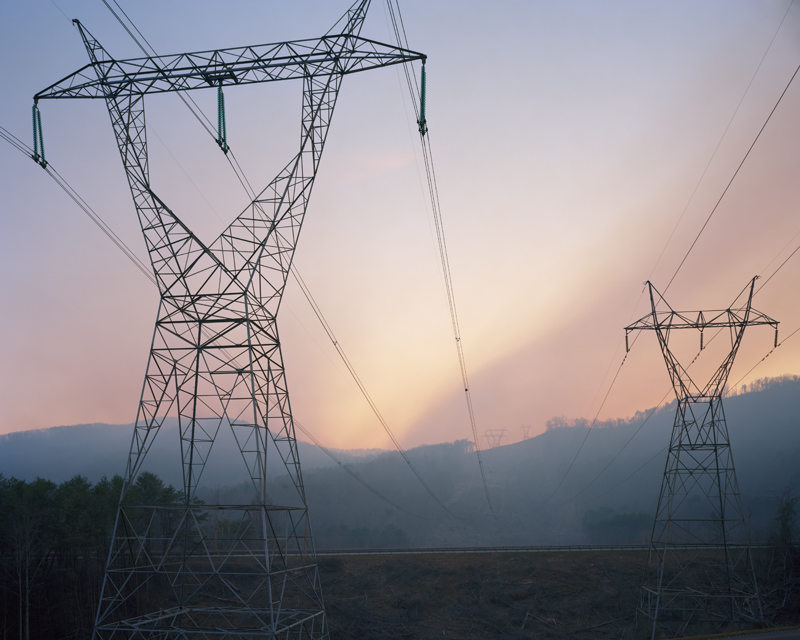Portraying Appalachia
By Oxford American

“Forest Fire and I-24, Mill Creek, Whiteside, Tennessee, 2011,” by Jeff Rich
“The tragedy of Central Appalachia is that it is becoming more marginalized in American life just when the country needs more than ever what it has to offer.”
—Henry M. Caudill, Night Comes to the Cumberlands (1962)
In September 1967, the murder of a Canadian filmmaker in the mountains of eastern Kentucky brought national attention to the tension between insiders and outsiders in Appalachia. Hugh O’Connor was working on a film about life in America—commissioned by the U.S. Department of Commerce—and had just secured the evocative image of a coal miner, dusty and tired from work, seated on the front porch of his shack home, when the property owner, Hobart Ison, drove up and shot the stranger with the camera. The people of Appalachia, long depicted as the regional face of American poverty, were fed up with that stereotype. They were tired of the journalists who came to town in search of further evidence of it.
Any person who holds up a camera to Appalachia must contend with the long, contested history of representation and exploitation in the region. Appalachia is too big and too old a place to be neatly captured and defined, or accurately portrayed in a single photograph, or even a series.
In January, the Oxford American’s weekly online photography feature, Eyes on the South, curated by Jeff Rich, included a selection of images of Appalachia by Los Angeles–based photographer Stacy Kranitz. In her project As it Was Give(n) to me… Kranitz explicitly engaged the controversial legacy of Appalachian representation. In her artist’s statement, she wrote:
Representing place is a complicated series of negotiations. How can the photographer demystify stereotypes, represent culture, sum up experience, interpret memory and history? I create a fantasy world for myself. My perceptions and fantasies rival my desire to provide a realistic portrayal of where I am, especially because the idea of a “realistic portrayal” is a fantasy. My work is about the tension between these two desires. If in fact they are two. Maybe they are just one.
Reader response to the series was fervent and varied. On Facebook, commenters were angered by Kranitz's intentionally ambiguous blend of fantasy and realism. On Instagram, viewers praised exactly that. We thought the conversation deserved further, more rigorous consideration, so the OA asked several artists who have worked in the region to contribute short essays on the subject of Portraying Appalachia.
—The Editors
LOOKING WITHOUT FEAR
In looking at Appalachia—not just from the outside, but from within as well—we reveal more about ourselves as observers than the region objectively. The subjects show us shades of our own individuality. That’s not easy to unpack, or even admit to, but I think it is why some depictions of Appalachia make us uncomfortable.
By Roger May
THE HISTORICAL AND THE POETIC
One morning in February, I woke up to the tragic news of Jamie Coot’s death from a venomous snakebite. I’ve been documenting the Pentecostal Holiness community since 2011, and this was the second time I’ve witnessed the devastating impact of a pastor’s death on a congregation. These profound events have had an immeasurable impact on my understanding of ethical representation and my belief in the integrity of documentary practice.
By Kate Fowler
HELL WITH THE LID TAKEN OFF
For more than a century, Pittsburgh has existed in the shadow of its own industrial-age narrative. Like much of Appalachia, Pittsburgh is a place dogged by stereotypes and assumptions. In recent years, an increasing number of photographers have come to western Pennsylvania with the intent of documenting the aftermath of the steel industry’s collapse. Some offer a fresh take on the present, others reinforce the limited views of the past.
By Matthew Newton
LIVING UP THE CREEK
I believe that finding one’s place in the world is every individual’s most challenging question. It comes easy to some, but for many others finding that spot requires much groveling and hunting to get there. I have always fallen in with the groveling crowd.
By Rob Amberg


